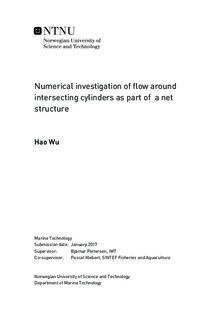| dc.description.abstract | Interference effects occurs in the wake of cylindrical bodies. In marine fishery and aquaculture industry, circular cylinder is very common in offshore fish farm. The cage, as a knot structure, is consist of intersecting ropes. Assuming the deformation on the fish cage is negligible, one can simplify the net into multiple intersecting cylinders. This thesis investigates the flow through a cross-cylinder structure in a numerical method. A RANS approach is applied to accomplish the modeling.
In this thesis, two cases are considered. The first case is a three dimensional modeling of flow around a circular cylinder in a uniform flow. The Reynolds number is 3900, very close to the second case and frequently used in published articles. As a preliminary job, this case investigates the suitable numerical environment for an ambient flow problem including the geometry of domain, grid generation and solver setups. A series of published articles from both experimental and numerical studies are used in comparison to the present simulation. By doing a mesh convergence test, a relatively fine mesh is obtained with the $y^{+}$ less than 1 at the first cell layer. Through a parameter analysis, a $k-\omega$ SST turbulence model is selected. The boundary conditions and a suitable time step are also determined. This case gives reasonable results such as velocity and force coefficients after a comparison to the previous work. The CFD model run by ANSYS Fluent is proved to be sufficient for the flow problem with more complicated geometry.
The second case is a cruciform circular cylinder in a uniform flow subjected to Reynolds number 6400. The discussion in the first case gives experience to set up the numerical model. The geometry of domain and structure is based on a PIV model test by Department of Marine Technology at NTNU. Mesh quality is checked by a series of mesh metrics. The characteristics of the fluid flow, such as velocity and pressure, are obtained. In order to validate the model, velocity contours and pressure distribution at different planes are compared with the measurements from corresponding physical model tests. The comparisons show that the numerical results are in an overall agreement with the experimental data. Some interesting phenomenon are also found such as the secondary flow in the spanwise direction. | |

